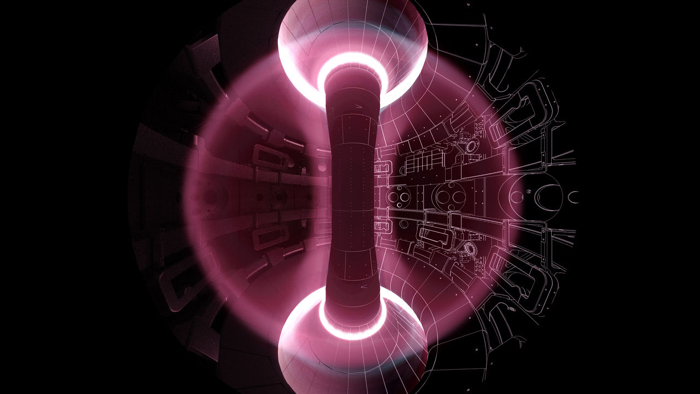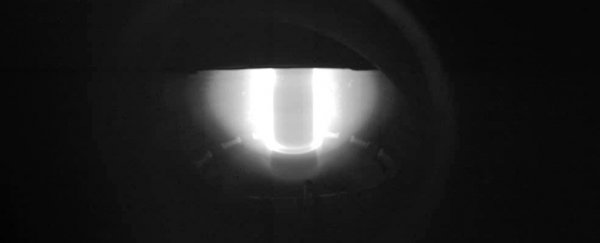After a long, seven-year development, an experimental fusion reactor in the UK has been successfully powered on for the time, achieving 'first plasma': confirmation that all its components can work together to heat hydrogen gas into the plasma phase of matter.
This transition – achieved last week by a machine called MAST Upgrade in Culham, Oxfordshire – is the fundamental ingredient of a working nuclear fusion reactor, a dream scientists have been trying to realise for decades.
In nuclear fusion, the nuclei of two or more lighter elements fuse into a heavier nucleus, and release energy. This phenomenon is what goes on in the heart of the Sun, and if we can recreate and maintain the same reactions on Earth at sufficient scale, we stand to reap the rewards of clean, virtually limitless, low-carbon energy.
 Artist's impression of the MAST Upgrade tokamak. (CCFE/UKAEA)
Artist's impression of the MAST Upgrade tokamak. (CCFE/UKAEA)
Not that we're there quite yet, but the successful completion and first test run of MAST Upgrade is a significant milestone in the journey. The original MAST (Mega Amp Spherical Tokamak) facility ran from 1999 to 2013, and its successor has been in the works ever since, so it's an important proof of concept.
"We want the UK to be a world leader in fusion energy and to capitalise on its amazing potential as a clean energy source that could last for hundreds of years," UK Science Minister Amanda Solloway said in a statement.
"Powering up the MAST Upgrade device is a landmark moment for this national fusion experiment and takes us another step closer towards our goal of building the UK's first fusion power plant by 2040."
A fusion reactor requires some sort of device to harness the reactions occurring in the plasma. Tokamaks - circular devices that use magnetic fields to contain the plasma created by the fusion reaction - are one of the leading designs for such a device.
For a long time, tokamaks employed a doughnut-shaped configuration, but newer devices like MAST Upgrade are examples of a more advanced spherical tokamak design, expected to provide numerous benefits in terms of efficiency and performance.
MAST Upgrade, which is operated by the Culham Centre for Fusion Energy (CCFE), which is part of the UK Atomic Energy Authority (UKAEA), will need all those advantages, too. Now that it's operational, the fusion experiment has some pretty big challenges to solve over the next several years.

First and foremost among these is heat exhaust. Fusion reactors create incredible amounts of heat that can damage the reactor's components. To fix this problem, MAST Upgrade will be trialling a new kind of exhaust system called the 'Super-X divertor', designed to reduce heat and power loads from particles leaving the plasma.
If the divertor is successful, it could offer a 10-fold heat reduction compared to what's been possible before now, which might be sufficient to make fusion reactors a cost-effective technology in future power plants.
That's a big if, but everything about fusion reactors is big, and MAST Upgrade – despite being a huge project that took seven years to build – is only a small part of the whole puzzle.
The device is actually a trial run for an even bigger project, the Spherical Tokamak for Energy Production (STEP), which will be the UK's first prototype fusion power plant, expected to be finished by 2040.
In the meantime, what researchers can learn from MAST Upgrade will also inform another massive venture: the world's largest nuclear fusion experiment, called the International Thermonuclear Experimental Reactor (ITER).
ITER is currently being assembled in southern France, involving thousands of scientists from over 30 countries. It's been in planning for years, and is about five years behind schedule, but when the project is complete (estimated to cost in the vicinity of US$65 billion), ITER will be our best chance yet of showing that the energy produced by nuclear fusion can be harnessed by human hands.
We may be years away from the discovery, but MAST Upgrade is a big step forward to getting us there.
"ITER is the next generation of fusion device," explains CCFE physicist Andrew Thornton.
"MAST Upgrade will support it by providing data from experiments we do here to direct how to run that machine in the future."
